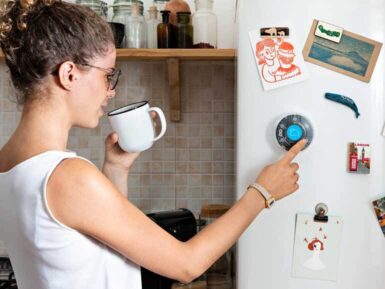
USB-C to HDMI multiport adapter 4K, USB hub, PD pass through
USB-C Multiport adapter | HDMI | 4K | 60W | PD Pass Through | 1x USB-A | 0.15m | Aluminium
Overview
Use the USB-C 3.2 Gen1 to HDMI 4K adapter to connect a HDMI screen or beamer to a notebook. The adapter supports a maximum resolution of 4096 x 2160 (4K) @ 30Hz. The AC7022 has a Power Delivery Pass-Through port (max. 60W) and an additional USB-A port.
- Solid aluminium USB-C 3.2 Gen1 to HDMI video adapter with a max. resolution of 4096 x 2160 (4K) @30Hz
- 60W Power Delivery Pass-Through port for charging your connected device
- USB-A 3.2 Gen1 data port
- Plug and play: a USB-C port with DisplayPort Alternate Mode (DP Alt Mode) is needed
Connect a notebook with USB-C to a monitor or beamer with HDMI
Connect a source device with USB-C to a monitor or beamer with HDMI by using the USB-C 3.2 Gen1 to HDMI adapter. The USB-C port of the source device must support DP Alt Mode. The USB-C to HDMI Adapter supports the maximum resolution of 4096 x 2160 (4K) @ 30Hz. The AC7022 has an additional USB-A data port.
USB-C Power Delivery Pass-Through port 60W
The USB-C Pass-Through port supports power delivery 60W. The notebook is always charged with the right amount of power thanks to the pre-defined Power Delivery profiles. The charger communicates with the notebook to negotiate the most effective charging profile.
Tech specs
| Product category | USB-C multiport adapters |
| USB Type-C | Yes |
| Length cable | 0.12 m |
| Shielding type | Aluminum Mylar |
| Conductor material | Tinned copper |
| Wire gauge | 32 AWG |
| Power Delivery ports | 1 |
| Max. Power Delivery power | 60 W |
| Supported Power Delivery profiles | 12.0V up to 2.58A, 15.0V up to 2.67A, 20.0V up to 2.75A, 9.0V up to 2.44A |
| Colour | Grey |
| Connections | HDMI, USB |
| Connections (computer) | USB C male (x1) |
| Connections (display) | HDMI A (full-size) female (x1) |
| 4K compatible | Yes |
| Max. resolution @ 30Hz | 3840 x 2160 |
| Max. resolution @ 60Hz | 1920 x 1080 |
| Chroma sampling | 4:04:04 |
| Video signal | HDMI |
| Video specification | HDMI High Speed |
| USB version | USB 3.2 Gen 1 - SuperSpeed (USB 3.0) |
| System requirements | USB Alternate mode |
| Power supply | Bus powered |
Get Inspired
Weather forecast for 7 days and current (local) weather data displayer using the Arduino Opla IoT Kit

We’re excited to announce the launch of the Arduino Oplà Kit, the first open programmable IoT platform that allows you to add smart connectivity to the devices around your home or workplace and build custom IoT devices. The Oplà IoT Kit contains all the hardware necessary to create eight connected applications, access to an online platform with assembly instructions, and a 12-month subscription to the Arduino Create Maker Plan. This kit is perfect for beginners with basic DIY experience, while more advanced users can leverage it to customize and hack their smart applications and devices, with full control of their data and processes. Eight out-of-the-box projects to connect your home or workplace The projects included in the Oplà IoT Kit enable users to turn everyday appliances into smart appliances, which can be controlled remotely on a mobile phone: Remote Controlled Lights — Change color, light modes, and switch on/offPersonal Weather Station — Record and monitor local weather conditionsHome Security Alarm — Detect motion and trigger warningsSolar System Tracker — Retrieve data from planets and moons in the solar systemInventory Control — Track goods in and outSmart Garden — Monitor and manage the environment for your plantsThermostat Control — Smart control for heating and cooling systemsThinking About You — Send messages between the kit and the Arduino IoT Cloud Create, connect, control. The Internet of Things has never been so easy! No soldering is required with the Oplà IoT Kit, which is based on a MKR IoT carrier with an OLED color display, on-board environmental sensors, and capacitive touch buttons. The kit also includes a MKR WiFi 1010 board, a circular plastic enclosure and supporting accessories, such as two cables, a motion sensor, a moisture sensor, and a USB cable. To build applications, users can rely on the Oplà online platform. Each project includes goals, an intro to the components,







